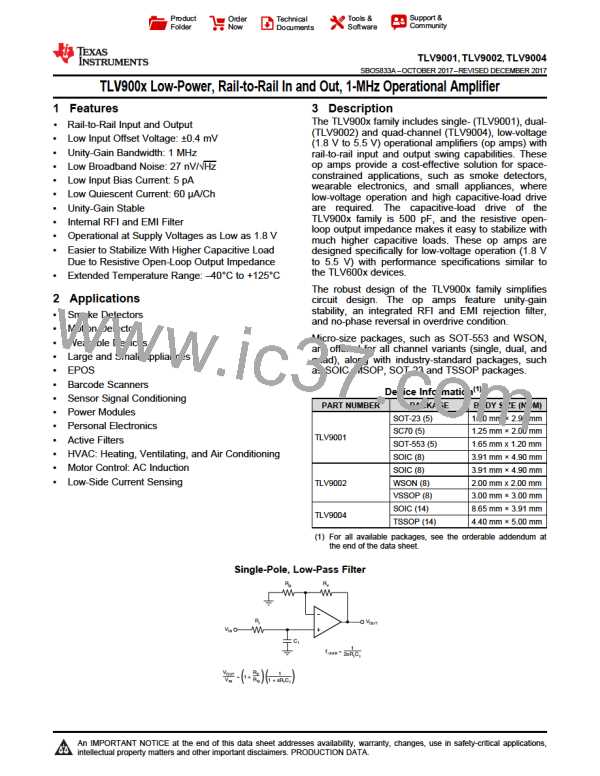TLV9001, TLV9002, TLV9004
SBOS833A –OCTOBER 2017–REVISED DECEMBER 2017
www.ti.com
Typical Application (continued)
The load current (ILOAD) produces a voltage drop across the shunt resistor (RSHUNT). The load current is set from
0 A to 1 A. To keep the shunt voltage below 100 mV at maximum load current, the largest shunt resistor is
defined using Equation 2:
VSHUNT _MAX
100mV
1A
RSHUNT
=
=
=100mW
ILOAD_MAX
(2)
Using Equation 2, RSHUNT is calculated to be 100 mΩ. The voltage drop produced by ILOAD and RSHUNT is
amplified by the TLV900x to produce an output voltage of roughly 0 V to 4.9 V. The gain needed by the TLV900x
to produce the necessary output voltage is calculated using Equation 3:
V
OUT _MAX - VOUT _MIN
(
)
Gain =
VIN_MAX - V
IN_MIN
(3)
Using Equation 3, the required gain is calculated to be 49 V/V, which is set with resistors RF and RG. Equation 4
is used to size the resistors, RF and RG, to set the gain of the TLV900x to 49 V/V.
R
(
)
F
Gain = 1+
R
G
(4)
Choosing RF as 57.6 kΩ and RG as 1.2 kΩ provides a combination that equals 49 V/V. Figure 38 shows the
measured transfer function of the circuit shown in Figure 37.
8.2.1.3 Application Curve
5
4
3
2
1
0
0
0.2
0.4
0.6
0.8
1
ILOAD (A)
C219
Figure 38. Low-Side, Current-Sense, Transfer Function
8.2.2 Single-Supply Photodiode Amplifier
Photodiodes are used in many applications to convert light signals to electrical signals. The current through the
photodiode is proportional to the light energy applied to it and is commonly in the range of a few hundred
picoamps to a few tens of microamps. An amplifier in a transimpedance configuration is typically used to convert
the low-level photodiode current to a voltage signal suitable for processing in an MCU. The circuit shown in
Figure 39 is an example single-supply photodiode amplifier circuit using the TLV9002.
18
Submit Documentation Feedback
Copyright © 2017, Texas Instruments Incorporated
Product Folder Links: TLV9001 TLV9002 TLV9004

 ETC [ ETC ]
ETC [ ETC ]